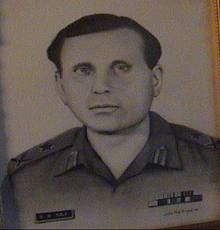
Rtd Major General A. S. Guraya (Photo: assamrifles.gov.in).
This General fascinated me, not because of his contribution to Lisu society but because he is significant to Dawodi history. He chased Lisu away from home villages, resettled 200 Nepali ex-army, renamed two villages, discovered Vijoynagar under his leadership and so on. So this is a short attempt to know this man who changed Dawodi history forever after 1961.
Older Lisu villagers know him by the name “Nawahla” (big ear), because he wore a hat like those of cowboys in the west. Some at best called him “Guliya” (for there is no R sound in Lisu). They remember Guraya used to come on horseback with a hat. None of them knew his actual name. Only very recent I learned his complete name – Ajit Singh Guraya!
Below are few sketch of Rtd Major General A. S. Guraya:
- He was son of Subedar Thakur Singh, an officer of M.C. Order of British India.
- Functioned as the Vice Chairman of Assam Rifles Multi-purpose Co-operative Society Limited between 1987 – 89.
- He filed the Government of India and received the verdict on May 1, 1989. The objective was to obtain the promise: “allotment of land, grant of title deeds in respect of the allotted land, facilities for movement by air to and from Mohanbari, freedom to develop the allotted areas, grant of advance by way of loans, provision of marketing facilities for disposal of surplus”. The govt filed counter-affidavits and most of the allegations were denied.
- Visited Vijoynagar around November 1961 (Maitra 1993) as second Chaukan expedition.
- Renamed Daodi as Vijoynagar after his only son, Vijay, and Yibedi as Pritnagar after his only daughter, Priti.
- In office as the Major General of the Assam Rifles between 01 Feb 1958 – 14 Dec 1965.
- During his tenure, he settled 200 families of the ex-service personnel.
- Looks like he tried to get an allotment of land for him in Vijoynagar. Later in 1989 before the Supreme Court that he was not interested to have land for him.
- He was awarded AVSM (Ati Vishisht Seva Medal) for expeditions in Vijoynagar (Year?). AVSM is a military award given to recognize “distinguished service of an exceptional order” to all ranks of the armed forces.
- Around 1993, he sought permission to visit Vijoynagar but was denied by the then Chief Secretary of Arunachal Pradesh, Mr. Taka Limbu, who later became a member of the North East Council.
Our perception for this General is summarized well in this quote:
“To some people especially the Nazis and his followers, Hitler was a hero figure. However, to many Jews and the mankind he was a dictator and a destroyer. Similarly, to the aboriginal tribal inhabitants of Dawodi valley (presently Vijoynagar) A.S. Guraya was a dictator and a destroyer, who was responsible in forcing the indigenous Yobin dwellers to vacate their own cultivated land at gunpoint to make room for a new bunch of settlers into their land. A few years back there was a time when inner line pass was denied to Mr. A.S. Guraya and his children to enter and visit Dawodi valley (presently Vijoynagar), certainly there were some reasons the Arunachal Government had to consider.”
— Mr. R. Yobin commented (Readers’ Forum of AP Times, 10 March 2013).
References:
Maitra, Asim. 1993. Profile of a Little-Known Tribe: An Ethnographic Study of Lisus of Arunachal Pradesh. New Delhi: Mittal Publications. Page 9.
http://www.assamrifles.gov.in/leadership.aspx
Readers’ Forum of Arunachal Times (arunachaltimes.in).







